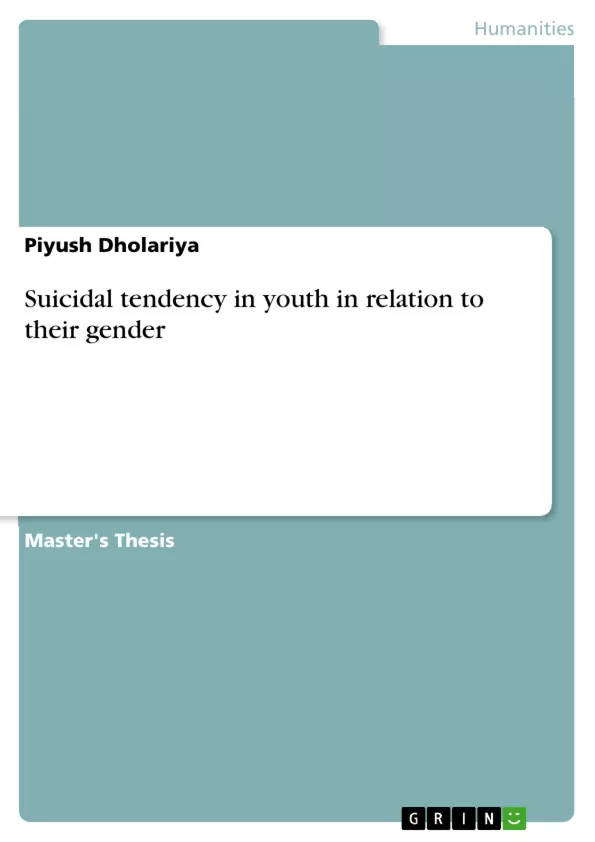The suicide rate among children and adolescents in the world has increased dramatically in recent years. It has been accompanied by substantial changes in the leading methods of youth suicide, especially among young girls. Much work is underway to elucidate the relationships between psychopathology, substance use, child abuse, bullying, internet use, and youth suicidal behaviour. Recent evidence also suggests sex-specific and moderating roles of gender in influencing risk for suicide and suicidal behaviour.
Suicide is the third leading cause of death among adolescents globally, accounting for 11% of all deaths to youth ages 12 to 19 between 1999 and 2006, and rates of attempting suicide and suicidal ideation are higher than those of completed suicide. According to the Centers for Disease Control and Prevention, 157,000 youth between the ages of 10 and 24 receive medical care at emergency departments for self-inflicted injuries each year. Data from the 2011 National Youth Risk Behavior Survey show that 16% of youth reported seriously considering suicide, 13% reported creating a plan, and 8% reported trying to take their own lives in the 12 months preceding the survey. The bulk of existing research on adolescent suicide focuses on psychological explanations and individual-level risk factors for suicide, including mental health, substance use patterns, and exposure to traumatic life events, such as sexual abuse.
This work is critical because it identifies individuals at the greatest risk of suicide and provides clear intervention strategies to address individuals’ unique paths to suicidal ideation.
Inhaltsverzeichnis (Table of Contents)
- Abstract
- Introduction
- Review of literature
- Significance of the Study
- Objectives
- Hypothesis
- Methodology
- Result and Discussion
- Conclusion
- Limitations
- Suggestions
- References
Zielsetzung und Themenschwerpunkte (Objectives and Key Themes)
This study examines the prevalence of suicidal tendencies among youth, focusing on the relationship between gender and suicide risk. The research aims to understand the factors contributing to suicidal ideation and attempts in young people, particularly considering the potential differences between genders.
- The prevalence of suicidal ideation and attempts in youth.
- The impact of gender on suicide risk in adolescents.
- The role of individual and social factors in suicidal behavior.
- The importance of early intervention strategies for suicide prevention.
Zusammenfassung der Kapitel (Chapter Summaries)
- Abstract: This chapter provides a concise overview of the study's focus on the increasing suicide rate among youth and the importance of understanding the relationship between gender and suicidal behavior.
- Introduction: This chapter delves into the background of suicide among youth, including statistics on the prevalence of suicidal ideation and attempts, and the significance of considering gender as a factor in suicide risk.
- Review of literature: This chapter presents a comprehensive review of existing research on suicide among adolescents, focusing on the psychological, social, and cultural factors that contribute to suicidal behavior.
- Significance of the Study: This chapter highlights the importance of the study in addressing the growing concern of suicide among youth and the need for a better understanding of the role of gender in suicide risk.
- Objectives: This chapter outlines the specific goals of the study, including identifying the prevalence of suicidal ideation and attempts in youth and examining the relationship between gender and suicide risk.
- Hypothesis: This chapter presents the research hypotheses that will be tested in the study, focusing on the potential differences in suicidal tendencies between genders.
- Methodology: This chapter describes the research design, sample selection, data collection methods, and statistical analyses used in the study.
- Result and Discussion: This chapter presents the findings of the study, analyzing the data collected and discussing the implications of the results in relation to the research questions and hypotheses.
- Limitations: This chapter acknowledges the limitations of the study, considering any potential biases or constraints that may have influenced the findings.
- Suggestions: This chapter presents recommendations for future research and interventions based on the findings of the study.
Schlüsselwörter (Keywords)
The study focuses on the critical concepts of **suicide**, **adolescents**, **youth**, **risk factors**, **epidemiology**, and **attempted suicide**. The research explores the relationship between these concepts and the influence of gender on suicidal behavior in young people.
- Quote paper
- Piyush Dholariya (Author), 2017, Suicidal tendency in youth in relation to their gender, Munich, GRIN Verlag, https://www.grin.com/document/369591



